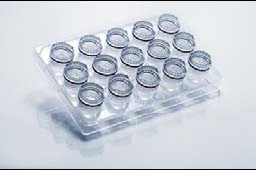Difference between revisions of "Main Page/BPHS 4090/Lysozyme Crystallization"
| Line 56: | Line 56: | ||
</td></table> | </td></table> | ||
<br style="clear: both" /> | <br style="clear: both" /> | ||
| + | <li>Repeat for the remaining lysozyme concentrations. You should have 4 drops on | ||
| + | each cover. Keep in mind where you place the different lysozyme concentrations by | ||
| + | referring to the notch.</li> | ||
| + | <li>Screw cover on reservoir.</li> | ||
| + | <li>Repeat for the remaining reservoirs in your row.</li> | ||
| + | <li>Incubate at room temperature.</li> | ||
| + | <li>Observe and document conditions in drops with microscope immediately after setup | ||
| + | and 1, 2 and 3 weeks later.</li> | ||
| + | </ol> | ||
| + | |||
| + | <p>Describe the results! Do you see any trends? How many crystals do you see per drop? | ||
| + | Which drop contains the largest crystals? Which drop contains the most crystals?</p> | ||
| + | |||
| + | Describe Vapor Diffusion as it pertains to crystal growth. | ||
| + | <table width=400 align=left ><td> | ||
| + | <p align=justify>[[File:Figure2.png|400px|border|center]] | ||
| + | <b>Figure 3:</b>Well setup for crystal growth by the vapour diffusion method | ||
| + | <br clear=right> | ||
| + | </p> | ||
| + | </td></table> | ||
Revision as of 12:26, 2 September 2010
Contents
Introduction
Three-dimensional Protein Structures
X-Ray Crystallography
What is a Protein Crystal?
Suggested Reading:
Introduction to Macromolecular X-Ray Crystallography by Esko Oksanen and Adrian Goldman (Chapter 10 in Comprehensive Natural Products II Chemistry and Biology, Editors-in-Chief: Lew Mander and Hung-Wen (Ben) Liu ISBN: 978-0-08- 045382-8).
Alexander McPherson. Introduction to protein crystallization. Methods, 34, 254-265.
Protein X-Ray Crystallography Methods by Roger S. Rowlett, Department of Chemistry, Colgate University
Websites
- http://www.ruppweb.org/level1/new_tutorials_page.htm
- http://www.sdsc.edu/Xtal/edu.index.html
- http://www.hamptonresearch.com
- http://www.pxuniverse.com/
Experimental
You will be provided with the pure protein (lysozyme) that you will be crystallizing. You will also be provided with the crystallization solution. In real life you perform crystallization trials with your homogeneously pure protein and examine your plates looking for protein crystals.
Crystallization Experiment I
Stock Solutions
Protein
Lysozyme at 25, 50, 75 and 100 mg/ml dissolved in 0.02 M sodium acetate pH 4.6
Lysozyme Crystallization Solution
- 0.6 M sodium chloride
- 0.1 M sodium acetate pH 4.6
- 25% Glycerol
Procedure
|
Figure 1: Crystallization Plate
|
- Fill reservoirs with 500 μl of lysozyme crystallization solution.
- Add 1 μl of the crystallization solution to 1 μl of lysozyme on the cover.
- Repeat for the remaining lysozyme concentrations. You should have 4 drops on each cover. Keep in mind where you place the different lysozyme concentrations by referring to the notch.
- Screw cover on reservoir.
- Repeat for the remaining reservoirs in your row.
- Incubate at room temperature.
- Observe and document conditions in drops with microscope immediately after setup and 1, 2 and 3 weeks later.
|
Figure 2
|
Describe the results! Do you see any trends? How many crystals do you see per drop? Which drop contains the largest crystals? Which drop contains the most crystals?
Describe Vapor Diffusion as it pertains to crystal growth.
|
Figure 3:Well setup for crystal growth by the vapour diffusion method
|

